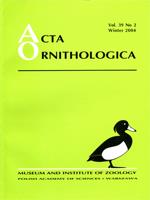The influence of the characteristics of habitat fragments on the dynamics of avian communities and the effect that fragments of different sizes have on the stability of the breeding species composition, and also on local extinction, colonisation and turnover rates were studied in an agricultural landscape in southern Poland. The fragments included various habitat types that differed from the matrix. Breeding birds were surveyed using the territory mapping method to assess turnover. Species composition depended on both the spatial structure of a fragment and the features of its surroundings. Local declines and appearances of species had a similar influence on the turnover in all size classes of the fragments. Species that contributed most to the total turnover were: Lanius collurio, Phasianus colchicus, Anas platyrhynchos, Emberiza schoeniclus, Columba palumbus and Sylvia communis. However, there were differences among species contributing most to the turnover according to area size classes. Heterogeneous habitats in a mosaic-like, agricultural landscape do not function as islands. The existence of species in an area with such a level of habitat patchiness can be related primarily to habitat quality, mainly because of poor isolation and the high permeability of isolating habitats.
How to translate text using browser tools
1 December 2004
Factors Affecting Temporal Dynamics of Avian Assemblages in a Heterogeneous Landscape
Stanisław Tworek
M. Baguette
,
B. Deceuninck
,
Y. Muller
1994. Effect of spruce afforestation on bird community dynamics in a native broad-leaved forest area. Acta Oecol. 15: 275–288. Google Scholar
G. Balent
,
B. Courtiade
1992. Modelling bird communities and landscape patterns relationships in a rural area of Southwestern France. Landscape Ecol. 6: 195–211. Google Scholar
J. M. Bentley
,
C. P. Catterall
1997. The use of bushland, corridors and linear remnants by birds in southeastern Queensland, Australia. Conserv. Biol. 11: 1173–1189. Google Scholar
C. J. Bibby
,
N. D. Burgess
,
D. A. Hill
1992. Bird census techniques. Academic Press, London. Google Scholar
L. Brotons
,
M. Mönkkönen
,
J. L. Martin
2003. Are fragments islands? Landscape context and density-area relationships in boreal forest birds. Am. Nat. 162: 343–357. Google Scholar
M. Cieślak
1994. The vulnerability of breeding birds to forest fragmentation. Acta Ornithol. 29: 29–38. Google Scholar
J. M. Diamond
1969. Avifaunal equilibria and species turnover rates on the Channel Islands of California. Proc. Nat. Acad. Sci. USA 69: 3199–3203. Google Scholar
P. F. Doherty
,
T. C. Grubb
2002. Survivorship of permanentresident birds in a fragmented forested landscape. Ecology 83: 844–857. Google Scholar
Z. Głowaciński
1981. Stability in bird communities during the secondary succession of a forest ecosystem. Ekol. pol. 29: 73–95. Google Scholar
J. M. Hagan
,
W. M. van der Haegen
,
P. S. McKinley
1996. The early development of forest fragmentation effects on birds. Conserv. Biol. 10: 188–202. Google Scholar
Y. Haila
2002. A conceptual genealogy of fragmentation research: from island biogeography to landscape ecology. Ecol. Appl. 12: 321–334. Google Scholar
Y. Haila
,
I. K. Hanski
,
J. Niemela
,
P. Puntilla
,
S. Raivio
,
H. Tukia
1994. Forestry and the boreal fauna: matching management with natural forest dynamic. Ann. Zool. Fenn. 31: 187–202. Google Scholar
I. Hanski
1994. A practical model of metapopulation dynamics. J. Anim. Ecol. 63: 151–162. Google Scholar
S. A. Hinsley
,
P. E. Bellamy
,
I. Newton
1995. Bird species turnover and stochastic extinction in woodland fragments. Ecography 18: 41–50. Google Scholar
R. J. Hobbs
1993. Effects of landscape fragmentation on ecosystem processes in the Western Australian wheatbelt. Biol. Conserv. 64: 193–201. Google Scholar
J. Jokimäki
,
E. Huhta
,
M. Mönkkönen
,
A. Nikula
2000. Temporal variation of bird assemblages in moderately fragmented and less-fragmented boreal forest landscapes: a multi-scale approach. Ecoscience 7: 256–266. Google Scholar
R. H. MacArthur
,
E. O. Wilson
1967. The theory of island biogeography. Princeton University Press, Princeton. Google Scholar
C. F. Mason
2001. Woodland area, species turnover and the conservation of bird assemblages in lowland England. Biodiv. Conserv. 10: 495–510. Google Scholar
E. Matthysen
,
F. Adriaensen
,
A.A. Dhondt
1995. Dispersal distances of nuthatches, Sitta europaea, in a highly fragmented landscape. Oikos 72: 375–381. Google Scholar
M. R. Norton
,
S. J. Hannon
,
F. K. A. Schmiegelow
2000. Fragments are not islands: patch vs landscape perspectives on songbird presence and abundance in a harvested boreal forest. Ecography 23: 209–223. Google Scholar
P. Opdam
1991. Metapopulation theory and habitat fragmentation: a review of holarctic breeding bird studies. Landscape Ecol. 5: 93–106. Google Scholar
B. S. Petersen
1998. The distribution of Danish farmland birds in relation to habitat characteristics. Ornis Fennica 75: 105–118. Google Scholar
J. Rolstad
1991. Consequences of forest fragmentation for the dynamics of bird populations: conceptual issues and the evidence. Biol. J. Linn. Soc. 42: 149–163. Google Scholar
D. A. Saunders
,
R. J. Hobbs
,
C. R. Margules
1991. Biological consequences of ecosystem fragmentation: a review. Conserv. Biol. 5: 18–29. Google Scholar
StatSoft Inc. 1997. Statistica for Window. Tulsa OK. Polish Edition by StatSoft Polska Sp. z o.o. Kraków, Poland. Google Scholar
S. Tworek
2001. Breeding bird communities in relation to different habitat islands. Nature Conserv. 58: 117–128. Google Scholar
S. Tworek
2002. Different bird strategies and their responses to habitat changes in an agricultural landscape. Ecol. Res. 17: 339–359. Google Scholar
S. Tworek
2003. Local extinction, colonisation and turnover rates of breeding birds in fragmented landscapes: differences between migratory guilds. Ornis Fennica 80: 49–62. Google Scholar
J. A. Wiens
,
C. S. Crawford
,
J. R. Gosz
1985. Boundary dynamics: a conceptual framework for studying landscape ecosystems. Oikos 45: 421–427. Google Scholar
D. S. Wilcove
,
C. H. McLellan
,
A. P. Dobson
1986. Habitat fragmentation in the temperate zone. In:
M. E. Soulé
(ed.).
Conservation Biology. The science of scarcity and diversity. Sinauer Associates, Massachusetts, USA, pp. 237–256. Google Scholar

Acta Ornithologica
Vol. 39 • No. 2
December 2004
Vol. 39 • No. 2
December 2004
colonisation
extinction
mosaic landscape
Species composition
species-area relationship
turnover rate




